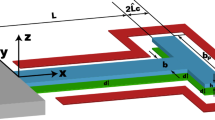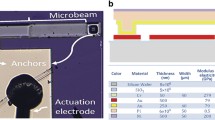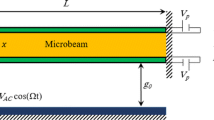Abstract
Static and dynamic analyses of an electrostatic microbeam under repulsive force actuation are presented. The repulsive force, created through a specific electrode configuration, generates a net electrostatic force on the beam pushing it away from the substrate. This allows large out-of-plane actuation and eliminates the pull-in instability. For example, a dynamic amplitude of 15 \(\upmu \)m was recorded for a 500-\(\upmu \)m-long cantilever at a DC voltage of 195 V and an AC voltage of 1 V, while the initial gap was only 2 \(\upmu \)m. This study includes mathematical modeling and simulations for a cantilever and a clamped–clamped beam, as well as experimental validation. The beam is modeled using Euler–Bernoulli beam theory and electromechanical coupling effects. Cantilever tip displacement, clamped–clamped midpoint deflection, and natural frequency shifts are reported. Governing equations are solved numerically using the shooting method, which provides a complete picture of the beam dynamics. The numerical results are verified with experimental data from fabricated beams using PolyMUMPs standard fabrication. Frequency response results reveal a mixed softening and hardening behavior and secondary resonances originating from quadratic and cubic nonlinearities in the governing equations. The analysis provides insight for applications in optical and gas sensors where a large signal-to-noise ratio and, sometimes, a wide frequency bandwidth are desired.















Similar content being viewed by others
References
Davis, Z.J., Svendsen, W., Boisen, A.: Design, fabrication and testing of a novel MEMS resonator for mass sensing applications. Microelectron. Eng. 84(5–8), 1601–1605 (2007)
Zhang, W.-M., Meng, G.: Nonlinear dynamic analysis of electrostatically actuated resonant MEMS sensors under parametric excitation. IEEE Sens. J. 7(3), 370–380 (2007)
Harish, K.M., Gallacher, B.J., Burdess, J.S., Neasham, J.A.: Experimental investigation of parametric and externally forced motion in resonant MEMS sensors. J. Micromech. Microeng. 19(1), 015021 (2008)
Chuang, C.-T., Chen, R.: Design, fabrication, and characterization of out-of-plane W-form microsprings for vertical comb electrodes capacitive sensor. J. Micro/Nanolithography MEMS MOEMS 8(3), 033021 (2009)
Hu, Z., Gallacher, B.J., Harish, K.M., Burdess, J.S.: An experimental study of high gain parametric amplification in MEMS. Sens. Actuators A Phys. 162(2), 145–154 (2010)
Frangi, A., Laghi, G., Langfelder, G., Minotti, P., Zerbini, S.: Optimization of sensing stators in capacitive MEMS operating at resonance. J. Microelectromech. Syst. 24(4), 1077–1084 (2015)
Sharma, M., Sarraf, E.H., Cretu, E.: Shaped combs and parametric amplification in inertial MEMS sensors. In: 2013 IEEE SENSORS, Baltimore, MD, 4 pages. (2013)
Jia, Y., Yan, J., Soga, K., Seshia, A.A.: Parametrically excited MEMS vibration energy harvesters with design approaches to overcome the initiation threshold amplitude. J. Micromech. Microeng. 23(11), 114007 (2013)
Park, J.Y., Lee, Y.P.: Modeling and characterization of piezoelectric d\(_{33}\)-Mode MEMS energy harvester. J. Microelectromech. Syst. 19(5), 1215–1222 (2010)
Jamain, U.M., Ibrahim, N.H., Ab Rahim, R.: Performance analysis of zinc oxide piezoelectric MEMS energy harvester. IEEE International Conference on Semiconductor Electronics, Proceedings, ICSE 4, 263–266 (2014)
Saadon, S., Wahab, Y.: From Ambient Vibrations to Green Energy Source: MEMS Piezoelectric Energy Harvester for Low Frequency Application. In: 2015 IEEE Student Symposium in Biomedical Engineering & Sciences (ISSBES) pp. 59–63 (2015)
Huang, F., Fouladi, S., Mansour, R.: A novel MEMS-based tunable dielectric resonator filter. In: IEEE MTT-S International Microwave Symposium Digest, pp. 2–5 (2011)
Shen, S.-H., Young, S.-T.: Design and fabrication of a MEMS filter bank for hearing aids applications. In: Proceedings (Cat. No. 02EX578) 2nd Annual International IEEE-EMBS Special Topic Conference on Microtechnologies in Medicine and Biology, pp. 352–355 (2002)
Diamantis, S., Ahmadi, M., Jullien, G.A., Miller, W.C.: A Programmable MEMS bandpass filter. In: Proceedings of the 43rd IEEE Midwest Symposium on Circuits and Systems (Cat. No. CH37144), pp. 522–525 (2000)
Huang, J.M., Liu, A.Q., Deng, Z.L., Zhang, Q.X.: A modeling and analysis of spring-shaped torsion micromirrors for low-voltage applications. Int. J. Mech. Sci. 48(6), 650–661 (2006)
Sharma, M., Sarraf, E.H., Cretu, E.: Parametric amplification/damping in MEMS gyroscopes. In: Proceedings of the IEEE International Conference on Micro Electro Mechanical Systems (MEMS), pp. 617–620 (2011)
Guo, C., Fedder, G.K.: Behavioral modeling of a CMOS-MEMS nonlinear parametric resonator. J. Microelectromech. Syst. 22(6), 1447–1457 (2013)
Rabih, A.A.S., Dennis, J.O., Abdullah, M.A.: Design, Modeling and Simulation of CMOS–MEMS Resonator for Biomedical Application. In: 2014 5th International Conference on Intelligent and Advanced Systems (ICIAS), pp. 4–9 (2014)
Rebeiz, G.M.: RF MEMS: Theory, Design, and Technology. Wiley, New York (2003)
Nathanson, H.C., NewellW, E., Wickstrom, R.A., Davis, J.R.: The resonant gate transistor. IEEE Trans. Electron Devices 3, 117–133 (1967)
Braghin, F., Resta, F., Leo, E., Spinola, G.: Nonlinear dynamics of vibrating MEMS. Sens. Actuators A Phys. 134(1), 98–108 (2007)
Ruzziconi, L., Bataineh, A.M., Younis, M.I., Cui, W., Lenci, S.: Nonlinear dynamics of a MEMS resonator: theoretical and experimental investigation. AIP Conf. Proc. 1493, 822–829 (2012)
Younis, M.I., Ouakad, H.M., Alsaleem, F.M., Miles, R., Cui, W.: Nonlinear dynamics of MEMS arches under harmonic electrostatic actuation. J. Microelectromech. Syst. 19(3), 647–656 (2010)
Towfighian, S., Heppler, G.R., Abdel-Rahman, E.M.: Analysis of a chaotic electrostatic micro-oscillator. J. Comput. Nonlinear Dyn. 6, 011001 (2011)
Ozdogan, M., Towfighian, S.: Nonlinear dynamic behavior of a bi-axial torsional MEMS mirror with sidewall electrodes. Micromachines 7(3), 42 (2016)
Towfighian, S., Seleim, A., Abdel-Rahman, E.M., Heppler, G.R.: A large-stroke electrostatic micro-actuator. J. Micromech. Microeng. 21(7), 075023 (2011)
Elshurafa, A.M., Khirallah, K., Tawfik, H.H., Emira, A., Aziz, A.K.S.A., Sedky, S.M.: Nonlinear dynamics of spring softening and hardening in folded-mems comb drive resonators. J. Microelectromech. Syst. 20(4), 943–958 (2011)
Lee, K.B., Cho, Y.H.: Laterally driven electrostatic repulsive-force microactuators using asymmetric field distribution. J. Microelectromech. Syst. 10(1), 128–136 (2001)
Shen, N., Kan, E.C.: Novel electrostatic repulsion forces in MEMS applications by nonvolatile charge injection. In: Technical Digest. MEMS 2002 IEEE International Conference. Fifteenth IEEE International Conference on Micro Electro Mechanical Systems (Cat. No. 02CH37266), pp. 598–601 (2002)
He, S., Ben Mrad, R.: Large-stroke microelectrostatic actuators for vertical translation of micromirrors used in adaptive optics. IEEE Trans. Ind. Electron. 52(4), 974–983 (2005)
Sugimoto, T., Nonaka, K., Horenstein, M.N.: Bidirectional electrostatic actuator operated with charge control. J. Microelectromech. Syst. 14(4), 718–724 (2005)
He, S., Ben Mrad, R.: Development of a multi-level repulsive force out-of-plane micro electrostatic actuator. In: IECON Proceedings (Industrial Electronics Conference), pp. 4020–4023 (2009)
He, S., Ben Mrad, R.: Design, modeling, and demonstration of a MEMS repulsive-force out-of-plane electrostatic micro actuator. J. Microelectromech. Syst. 17(3), 532–547 (2008)
Chong, J., He, S., Ben Mrad, R.: Control of a surface micromachined repulsive-force driven 2D micromirror. In: IEEE/ASME International Conference on Advanced Intelligent Mechatronics, AIM, pp. 1005–1007 (2010)
Fan, C., He, S.: A two-row interdigitating-finger repulsive-torque electrostatic actuator and its application to micromirror vector display. J. Microelectromech. Syst. 24(6), 2049–2061 (2015)
Li, G., Guo, X., Zhao, Q., Hu, J.: An Electrostatic Repulsive-Force Based Micro Actuator for Capacitive RF MEMS Switch, pp. 1095–1098 (2015)
Qiao, D.Y., Yuan, W.Z., Li, X.Y.: Design of an electrostatic repulsive-force based vertical micro actuator. In: Proceedings of 1st IEEE International Conference on Nano Micro Engineered and Molecular Systems, 1st IEEE-NEMS, vol. 90407020, pp. 168–171 (2006)
Younis, M.I.: MEMS Linear and Nonlinear Statics and Dynamics. Springer, New York (2011)
Rao, S.S.: Mechanical Vibrations, 5th edn. Prentice Hall, Upper Saddle River, NJ (2011)
Nayfeh, A.H., Balachandran, B.: Applied Nonlinear Dynamics: Analytical, Computational, and Experimental Methods. John Wiley & Sons, New York (1995)
Jaber, N., Ramini, A., Carreno, A.A.A., Younis, M.I.: Higher order modes excitation of electrostatically actuated clampedclamped microbeams: experimental and analytical investigation. J. Micromech. Microeng. 26(2), 025008 (2016)
Younis, M.I., Abdel-Rahman, E.M., Nayfeh, A.: A reduced-order model for electrically actuated microbeam-based MEMS. J. Microelectromech. Syst. 12(5), 672–680 (2003)
Ramini, R.H., Hennawi, Q.M., Younis, M.I.: Theoretical and experimental investigation of the nonlinear behavior of an electrically actuated in-plane MEMS arch. J. Microelectromech. Syst. 25(3), 570–578 (2016)
Ouakad, H.M., Younis, M.I.: Nonlinear dynamics of electrically actuated carbon nanotube resonators. J. Comput. Nonlinear Dyn. 5(1), 011009 (2010)
Nayfeh, A.H., Mook, D.T.: Nonlinear Oscillations. Wiley, New York (1979)
Acknowledgements
The authors would like to thank the Binghamton Analytical and Diagnostics Laboratory for a small grant to use their equipment during static testing. We would also like to thank Dr. Ronald Miles and Dr. Abdallah Ramini for their help with the dynamic testing. Partial support for this study was provided by NSF ECCS Grant 1608692.
Author information
Authors and Affiliations
Corresponding author
Appendix
Appendix
1.1 Harmonic balance
In addition to the numerical shooting technique, an analytical method of harmonic balance was also used to verify the shooting method results. A steady-state solution is assumed in the form of a Fourier series. This is plugged into the governing differential equation and coefficients of the harmonic terms are equated. This results in a coupled set of algebraic equations that can be solved numerically [45]. The steady-state solution of Eq. (5) is assumed to be in the form
where \(a_j\) and \(b_j\) are constants, and N is the number of harmonics to be considered. For the cantilever, good convergence occurs at two harmonics and above. If the AC voltage is low enough that the frequency response looks approximately linear, one harmonic provides a good estimate of the solution. However, if the AC voltage is high enough to produce significant softening, at least two harmonics are necessary for an accurate solution in the region of the resonant peak. It should also be noted that only one mode is to be considered for the harmonic balance calculation.
Equation (12) is then plugged into Eq. (5), and the coefficients of the harmonic terms, as well as the remaining non-harmonic terms, are equated. The non-harmonic terms solve for the static solution of Eq. (5), while the harmonic terms determine the dynamic solution. This procedure is performed using Mathematica.
Because the forcing function is a 5th-order polynomial, the coupled algebraic equations for \(a_j\) and \(b_j\) are nonlinear and are difficult to solve analytically. Therefore, the Newton–Raphson method is employed. Once \(a_j\) and \(b_j\) are known, the maximum steady-state amplitude can be obtained by the relation shown in Eq. (13),
Figure 16 shows the comparison between the shooting and harmonic balance methods (2 harmonics) for the case of \(V_\mathrm{DC}\) = 195 V and \(V_\mathrm{AC}\) = 1 V with largest softening behavior in Fig. 6. The two results are in close agreement. It is noted that the harmonic balance method also yields a similar softening behavior.
Next, this process is repeated for the clamped–clamped beam. Figure 17 depicts the comparison between the harmonic balance and shooting method results showing close agreement. For this case, only one harmonic is needed to show good agreement with the shooting method results.
Rights and permissions
About this article
Cite this article
Pallay, M., Daeichin, M. & Towfighian, S. Dynamic behavior of an electrostatic MEMS resonator with repulsive actuation. Nonlinear Dyn 89, 1525–1538 (2017). https://doi.org/10.1007/s11071-017-3532-z
Received:
Accepted:
Published:
Issue Date:
DOI: https://doi.org/10.1007/s11071-017-3532-z






